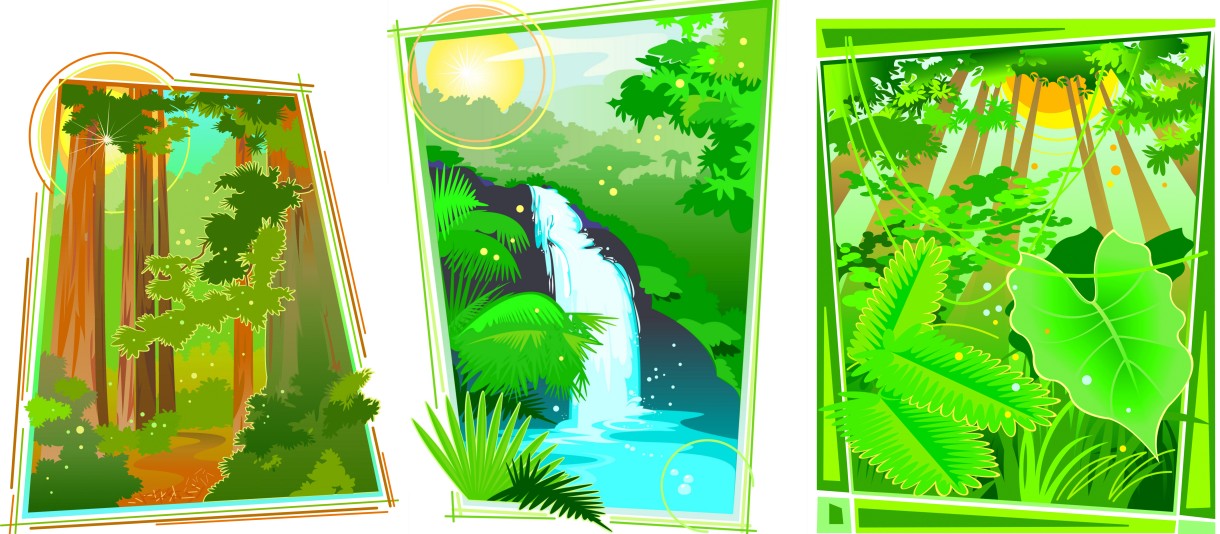
Wouldn't it be nice to have a
non-humid, air-conditioned, bug free Rain Forest
conveniently located inside the Houston's Loop 610?
|
Astrodome Update 1: May 2015
Written by Rick Archer
May 2015
Back in
September 2014, I published an article regarding possible
uses for the Houston Astrodome.
At the time, I
recommended turning the Astrodome into an air-conditioned
rain forest complete with restaurants and the world's
largest indoor river walk with a nod to San Antonio's main
attraction. Now I wish to
share some developments.
|
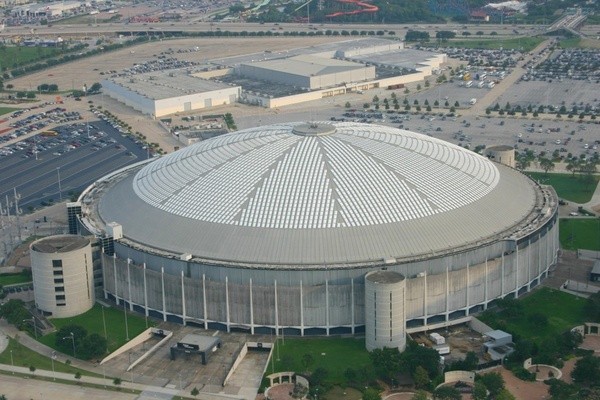 |
| |
Politics
In 2013, a $217
million bond to redesign the Astrodome lost the support of
Houston voters. 53 percent voted against it.
On a personal
note, I voted against it too. The plan was to turn the
Astrodome into a giant convention and event center.
My attitude was
simple: Houston does not need another convention center.
We already have the George R. Brown Convention Center.
We already have an exhibition hall standing next to the
Astrodome. Why pay all that money for something the
city doesn't need?
What
Houston needs is a tourist attraction!!
At the time,
most people expected the building to be torn down, but
miraculously it continued to stand.
That said,
Houston appears to still be divided as to what to do with
the Astrodome's future.
As an outsider
to Houston politics, I am totally dependent on the media to
understand what is going on. As everyone knows, the
media is quite reluctant to make enemies, so whatever I read
or hear is quite likely to be watered down.
Furthermore, as I have come to realize, the message in the
media is typically heavily controlled by moneyed interests
who wish to manipulate public opinion. Therefore I
have no idea what exactly is going on behind closed doors.
That said, my
gut tells me there is a huge power struggle taking place
between County Commissioner Ed Emmett and the people who
control NRG Stadium, the Texans football team, and the
Houston Livestock Rodeo.
Indeed, I ran
across this useful comment in the Houston Chronicle:
The Texans and Rodeo want the Astrodome demolished and
replaced by a park and parking spaces. The county
wants to keep the Dome in some fashion.
(source)
Last summer in
2014, my wife Marla and I took a trip to Vancouver, Canada.
I was in complete awe of the beauty in this area.
Tourist attractions abounded... Stanley Park, the Capistrano
Bridge, and ski resorts. There were also beautiful
buildings everywhere. It didn't take long to realize
these buildings had been erected in anticipation of the 2010
Winter Olympics that had been held in Vancouver.
Hosting these Olympics had clearly brought huge prosperity
to this region.
Recalling
Houston's failed effort to lure the 2012 Summer Olympics, I
could see that the physical beauty of the Vancouver region
had played a big part in luring the 2010 Olympics to the
city. I lamented that Vancouver had a huge advantage
over Houston in this area.
If
only Houston had a tourist attraction!!
When I returned
to home, it dawned on me that the Astrodome could be
remodeled on a grand scale to give Houston exactly what it
needs: A TOURIST ATTRACTION!
So in September
2014 I wrote my initial article on the
Astrodome
Project.
I put every idea
I could think of into the article... mountain, waterfall,
lagoon, river canals, restaurants, hanging bridges, Magic
Fountain, maze, Japanese garden, the works!
Then I emailed my
suggestion to Judge Emmett. I received absolutely no
response.
Considering I
had put two solid weeks into the effort, I was clearly
peeved. So I shrugged my shoulders and moved on.
Then to my
surprise, after seven months had passed, in late March 2015,
I received an email titled Astrodome Report.
The email was from Judge Emmett's office. Apparently
someone had noticed I had written them after all.
To my further
surprise... and delight... it looked suspiciously like Judge
Emmett is in favor of turning the Astrodome into a giant
indoor park. Judge Emmett announced he is planning to
visit Tropical Island Berlin in early May 2015.
|
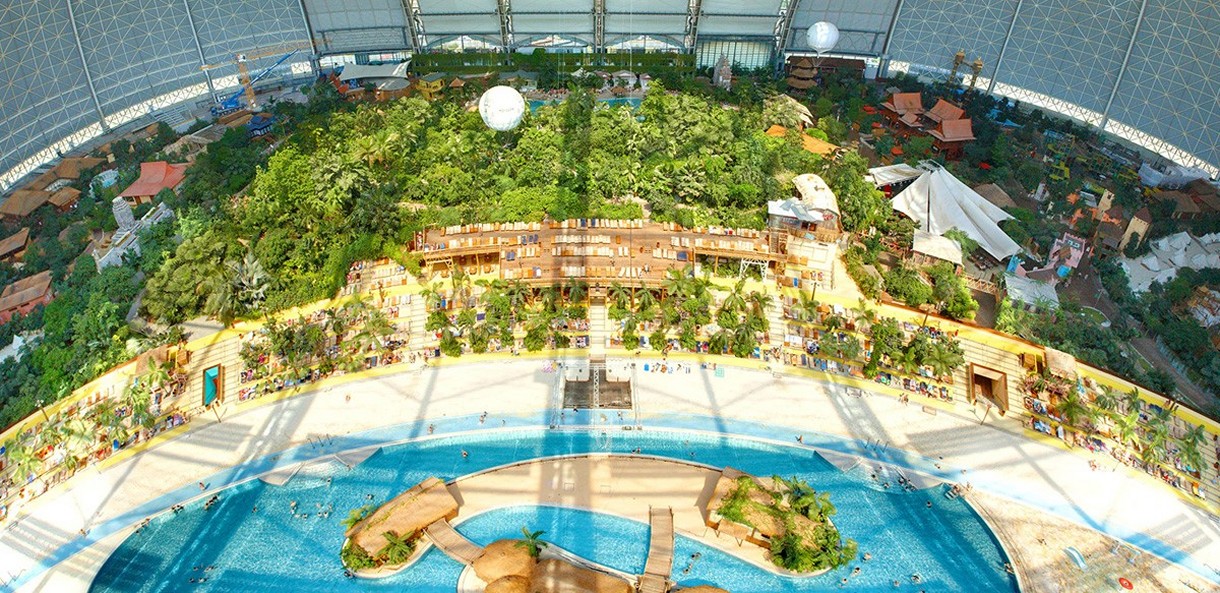
Tropical Island Berlin
Wikipedia
reports that
Cargolifter AG
bought a former military airfield 30 miles south of
Berlin and designed a hangar to create giant
zeppelin airships in 1992. At a cost €78
million ($87 million dollars), the hangar became the
world's largest single hall without supporting
pillars inside.
Commissioned as a place to
build large aircraft, unfortunately the airship the
oversized hangar was intended to house – the CL160 –
was never built.
CargoLifter
went bankrupt in mid-2002. One year later, the
Malaysian corporation Tanjong purchased the former
airship hangar and transformed it into the
Tropical Islands Resort.
Wikipedia pegged the cost of Tropical Islands
to be somewhere around €100 million. According to
figures published by the company, Tropical Islands
spent EURO 23 million on further development and
expansion work. The original total investment sum
announced was EURO 75 million, including a EURO 17
million subsidy from the federal state of
Brandenburg.
Tropical Islands
officially opened its doors on 19 December 2004.
Inside the hall, the air temperature is 78°F and air
humidity is around 64%. Tropical Islands is
home to the biggest indoor rainforest in the world,
a beach, many tropical plants and a number of
swimming pools, bars and restaurants. It is open
around the clock, every day of the year.
On entering the hall, visitors choose between
different basic admission options with different
prices. Visitors can move from one area to the other
by paying an additional daily charge. Additional
charges also apply for areas such as the water slide
tower, crazy golf course, African Jungle Lift,
evening show and internal accommodation area. The
entertainment program comprises a gala evening show,
smaller shows during the day (variety acts, kids'
entertainment) and various events.
The different
areas include the Tropical Village, featuring
accurate copies of traditional buildings from
Thailand, Borneo, Samoa and Bali. The
Rainforest contains 50,000 plants and 600
different species, including some rare plants.
The Tropical Sea is a 460 foot pool with an
area of 47,000 sq ft and a depth of 4 ft 5 in
designed to look like the waters of a coral island.
The Sandy Beach is 660 ft long complete with 850
wooden sun-loungers. The water temperature 82
°.
The
Bali Lagoon has an area of 13,000 sq ft) and a
depth of less than 3 feet in places. There are
fountains, a current canal, whirlpools and two water
slides; water temperature 90 °F.
Rick Archer's Note:
To be
honest, I never heard of this place before until a
few weeks ago.
However, the picture of a tropical setting
definitely caught my eye. Indeed, this place
was very similar to what I had envisioned when I
wrote my Astrodome
Project article.
Tropical Islands is 16 acres. The Astrodome is 9.5
acres.
Clearly
Tropical Islands has nearly twice as much surface
space as the Astrodome. That
said, the Astrodome doesn't need to waste space with
a giant ocean in the middle. A lagoon will do
just fine. Since Tropical Islands had so much
surface area to work with, I suppose there was no
need to develop upwards.
As the
picture shows, there is a surprising amount of
unused space at the hangar. What if they put
two, perhaps even three tiers inside the Astrodome?
Since
the Astrodome was built to withstand hurricanes, I
suspect the Astrodome has the ability to expand
upward and allow different levels to be built.
My
original plan called for a tier of elevated
restaurants that would rise above the floor level
and overlook the river canal system below. The
restaurants would be placed on a platform that would
extend 1/3rd of the way inward.
I would
extend the platform 2/3rds of the way around the
ring. In the third section, I would place a
giant mountain complete with the world's largest
indoor waterfall. The waterfall would create a
lagoon and the waters from the lagoon would create a
canal system utilizing all available surface below.
By using
a two-tier system, I imagine the Astrodome can pack
just as many interesting features as Tropical
Island.
Since I
am admittedly no architect, no doubt many of my
fanciful ideas are impractical. That said, it
doesn't hurt to dream.
|
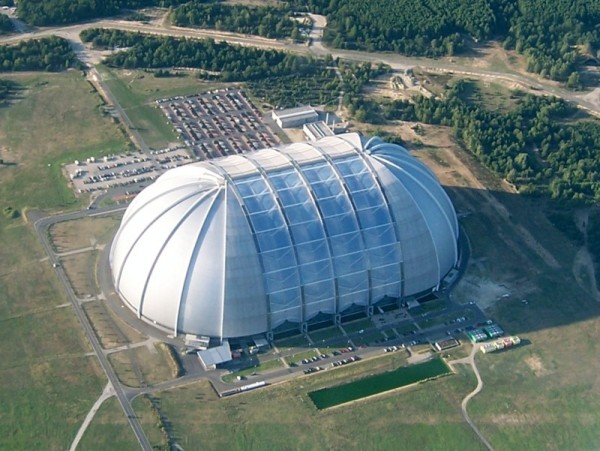
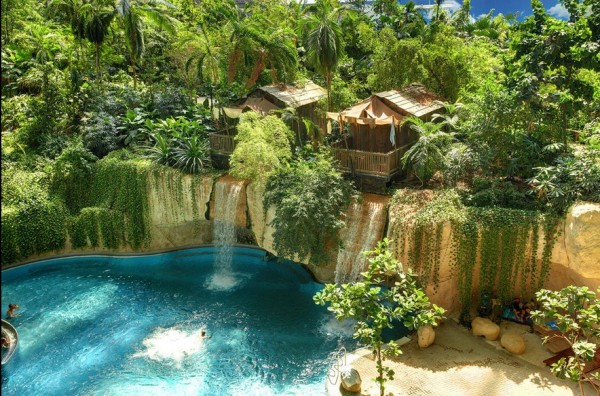
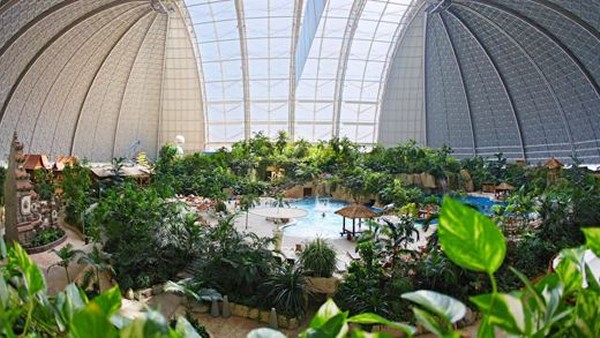
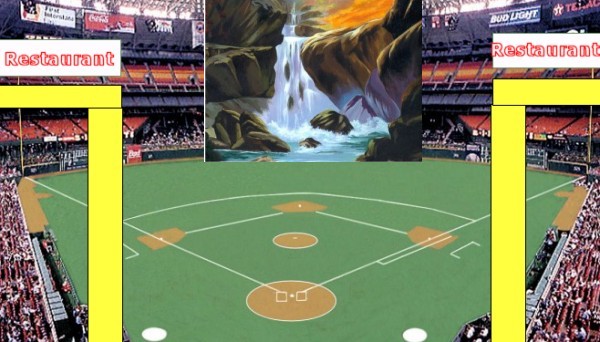 |
| |
|
The Product of
Fertile Imagination
|
| |
|
Rick Archer's Note:
I found an excellent
Tropical Islands article from the Daily
Mail, an online newspaper.
I have
posted these amazing photographs because I think
they provide a powerful demonstration of the
potential for something similar in the Astrodome.
|
 |
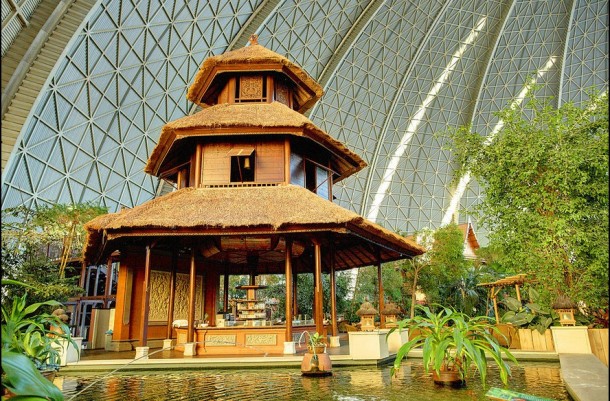 |
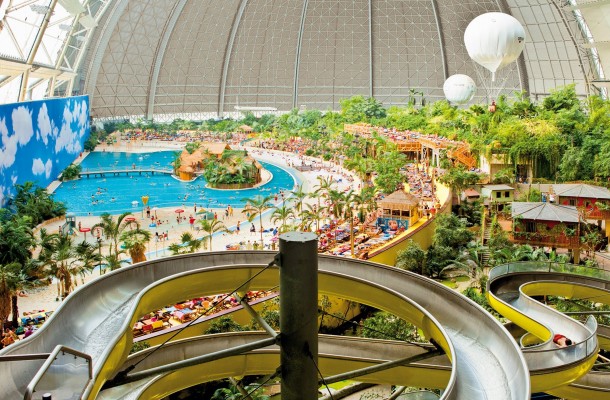 |
The eerie parallel between the airship hangar and
the Astrodome is unmistakable.
The airship hangar was a massive structure
just sitting there accomplishing nothing, so
they made it an indoor paradise.
The Astrodome was a massive structure just
sitting there accomplishing nothing, so
they... wanted to tear it down??
Germany has a harsh winter. In Berlin,
the citizens hunker down for four to five
long months of captivity. Meanwhile,
inside Tropical Gardens, as the
snowfall reaches as high as six feet outside
against the building's base, there are
175 million cubic feet of air kept at a
temperature of 79 degrees round-the-clock,
365 days a year.
It may be the dead of winter, but people walk around in
their bare feet. Meanwhile there are
eight football fields worth of landscaping
with plants fooled into thinking they are
growing in some Polynesian paradise in the
middle of German winter.
If the Germans can do it, why can't the
Texans do the same?
Houston has a harsh summer. With
temperatures approaching 100 degrees,
humidity that makes hot air cling to the
body, and mosquitoes driving everyone nuts,
citizens hunker down indoors for five months as they await October.
Meanwhile Houston has a structure so
powerful that it was built to withstand
hurricanes. The building is large enough to
house a climate-controlled indoor river walk
comparable to San Antonio's most famous
attraction. What if we had the guts to think
creatively how to make the Astrodome an
urban oasis?
What if we made the
Astrodome into the Pleasure Dome?
Build an artificial mountain fit for
climbing no less (using steps of course).
From the top of the mountain,
put
in the world's largest indoor waterfall.
Make it spectacular and make sure it can be
seen from every corner of the building.
Then tell the entire world about it!!
Build a river walk complete with parallel
walkways and restaurants lining the
waterways. Put in gondolas.
Have a stunning system of maze-like pathways
winding through a dense Rainforest.
Have a system of water canals complete
with romantic arched bridges above.
Think about it. No matter what the weather
conditions are outside, Houston's
inhospitable hot climate will pose no problem
year-round. The Astrodome will shield
us.
Houston will finally have a place to go on
New Year's Eve. The Astrodome can
house the biggest party in Houston.
Right after the Football game, people can
visit the Astrodome and have dinner while
the crowds dissipate.
What about a central area with a Lagoon to
showcase performances on a nightly basis?
Why not install a Magic Fountain like
Barcelona complete with music and light
show?
What about a raised platform for Rock bands
and C&W bands with a plaza below large
enough for the crowd to dance?
What about staging Cirque du Soleil-style
shows at night?
What about charging
admission to enter the place???
Every night can offer a different
performance meant to draw customers to
restaurants and bars that will be tastefully
woven into the complex. Over
margaritas and Mexican dinners, people can
watch the waterfall cascade from the ceiling
above and wave at people in the riverboats as they pass by
below.
Houston can have its very own Riverwalk.
We won't have to drive four hours to San
Antonio. We won't have to listen to
San Antonio brag about being the tourist center of
Texas.
We know this can be done. Germany has
already set the precedent. All we need
is the civic willpower.
|
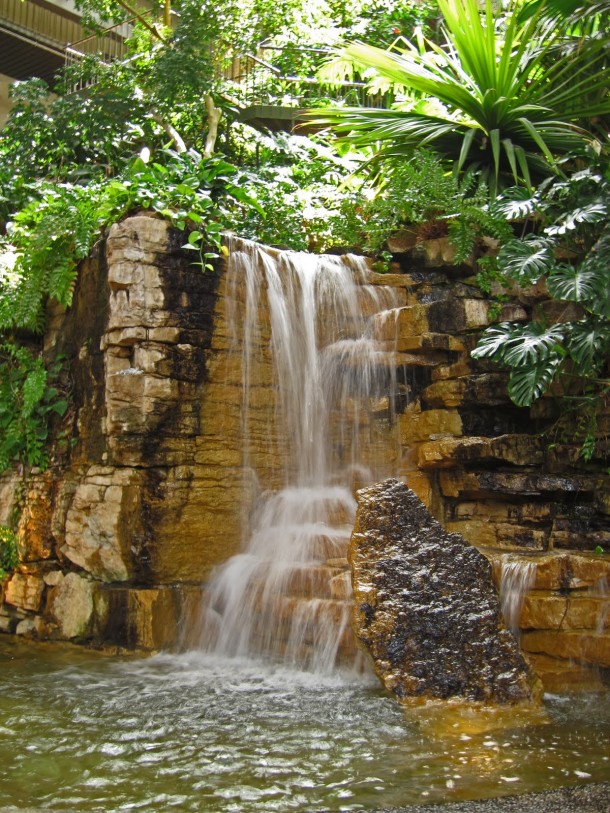
This is an example of a
beautiful indoor waterfall.
Why not put an even bigger waterfall in the
Astrodome?
Put
in a giant mountain and let the waters cascade
from the roof to the Lagoon below.
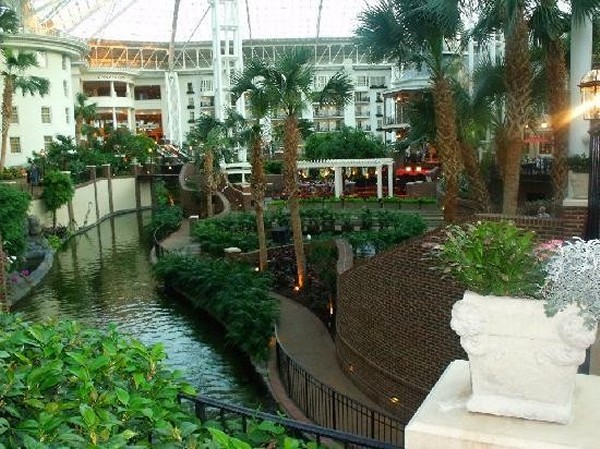
This is an indoor canal at
the Gaylord Hotel in Nashville.
This canal is wide enough and deep enough for riverboats
to sail through the complex.
Why not put an even larger canal system in the
Astrodome? |
|
|
|
BUT IT IS GOING
TO COST MONEY!!
|
Rick Archer's Note: Yes, it is
going to cost money to build the Pleasure Dome.
The Astrodome
has many enemies. Before I make my case in favor of
proceeding forward with this ambitious project, let's hear
from Chris Baldwin. Mr. Baldwin does a thorough job
stating why the Astrodome should be torn down.
|
2013: The Astrodome needs to be
blown up to make way for Houston's future Super (Bowl)
visions
By Chris Baldwin
2.26.13|3:39
pm
It's long
time for the Astrodome to be leveled to make way for
Houston's Super feature.
Astrodome?
The old Yankee Stadium — the
House that Ruth Built no less — started to get torn down
almost as soon as the new one was safely up.
The Astrodome still stands,
a rotting giant in a vast parking lot, 13 years after Minute
Maid Park debuted — five years after the fire marshal
shuttered it for good, leaving it for the rats and that
noxious dust. This isn't Fenway Park. It's not Wrigley
Field. It's not that old Yankee Stadium that went through
all those remodels. It's a relic that long ago lost its last
bit of charm.
And the Houstonians who
insist it needs to be "saved" are showing as much sense as
someone featured on Hoarders.
Blow it up — already!
This is
coming up (yet again) because the leaders of Houston's bid
committee for the 2017 Super Bowl were officially revealed
at Reliant Stadium Monday — in one of the few rooms not
commandeered by the Houston Livestock Show and Rodeo. While
everyone has known that former Secretary of State James
Baker III would be a key player since this year's Super Bowl
week, it was still impressive to see him standing in front
of that Houston Super Bowl LI logo.
With Baker
as the honorary chairman and Ric Campo, the self-made CEO of
Camden Property Trust, as the chairman, it's easier than
ever to see a clear path to Houston landing hosting duties
for another Super Bowl.
Houstonians
who insist it needs to be "saved" are showing as much sense
as someone featured on Hoarders.
As Texans
owner Bob McNair pointed out, it's not like Baker is some
politician or actor. He's "a statesman."
Houston has
the guy who helped bring down the freaking Berlin Wall
advocating for it. There is clout. And then there's clout.
Who is Miami
going to find to match James Baker III? Gloria
Estefan isn't going to cut it.
Houston is
on roll. National publications are tripping over themselves
to tout the Bayou City's "surprising" restaurant, museum and
cool kid cred. The NBA All-Star Weekend just rolled out of
town and H-Town proved to be more than party worthy for the
likes of Jay-Z, Michael Jordan and Charles Barkley. It's
hard to keep track of all the studies declaring Houston the
City of the Future.
And then you
get to the hulking ghost in the center what should be a
high-tech, hip sports and retail corridor. It doesn't matter
how gigantic Reliant Stadium's new video scoreboards are . .
. they can't hide the dump of the Astrodome.
"The Astrodome has been a problem for a while,"
Campo
said.
"And it continues to be a problem."
This just
isn't about one Super Bowl bid. Houston is already a
finalist for the 2017 game, set to compete against San
Francisco or Miami (those two cities are finalists for Super
Bowl 50 in 2016 and whichever one loses out will compete
against Houston for Super Bowl LI). It's about Houston
finally turning the page and embracing its future.
Yes,
imploding or tearing down the Astrodome — and making good
use of the space to create some there there around Reliant
Stadium — would help Houston's bid to host the 2017 Super
Bowl. As McNair noted, "You never know what might be the
difference in your bid."
But this
isn't a one week issue — not even if it is the biggest week
in American sports.
This is
about allowing the city to move on. When the Astrodome
opened in 1965, it deserved its Eighth Wonder of the World
moniker. It screamed innovation.
Now, it screams . . . embarrassment.
You know
what visiting sports writers inevitably ask about first when
they arrive in Houston? They
see the Astrodome sadly looming in a parking lot and wonder
why it's still there. This happens regularly at Texans
football games. It happened again and again during NBA
All-Star Weekend.
People from
elsewhere don't understand Houston's insistence on
continuing to pour money into a broken down stadium that,
let's face it, was already outdated 15 years after it
opened. Yes, the Astrodome hosted some great, monumental
events and it will forever live in the memories of local
sports fans.
But it's
simply not usable anymore. Kareem Abdul-Jabbar and Elvin
Hayes are not going to be strolling into the Astrodome to
relive their colossal clash. Those days are long over. Just
like the dome should be.
At one point
the Astrodome likely could have been salvaged. Some of the
ideas for its possible second life were intriguing, many
were downright absurd. No matter. That day is also long
gone.
There have
been more than enough multi-million studies. There is no
need to put off a decision yet again. Sometimes, the
simplest choice, the most obvious choice, is the best one.
Put together a demolition crew.
The Dome
Ghost
McNair is
not going to come right out and say that the Astrodome needs
to be torn down. The Texans owner isn't going to try and
dictate what the county commissioners do. It's not his way.
The Texans owner only allows that both his team and the
Rodeo could really use the space.
All of
Houston could use a new space. How about another Discovery
Green type park with a great hotel around it?
Houston's
Super Bowl bid will tout the impact of Discovery Green, how
it was used for big-time concerts during the 2011 Final
Four, how the new Marriott Marquis that is set to be built
closer to Minute Maid will add a further destination feel to
the area. Campo himself seems particularly enamored with
Marquis' "Texas waterway" on the fifth floor (the Lone Star
State-shaped pool CultureMap was first to report about on
Dec. 17).
What about a
second gathering place right by the stadium?
One thing is
sure. It's time for the Astrodome to make way.
In
officially accepting the Super Bowl job, Baker noted how
he's one of the "dwindling breed of native Houstonians." In
a city with a sometimes appalling history of leveling
perfectly-useable historic buildings, a broken down,
obsolete stadium is championed.
James Baker
brought down that wall. Who would ever thought the Astrodome
would be even harder to topple?
"I think
more than any other U.S. city, Houston maintains the brand
of entrepreneurial spirit and work ethic that has fueled our
nation," Baker said.
Except when
it comes to an old useless stadium that continues to haunt
as it wastes away.
Rick Archer's Note:
Please note Mr. Baldwin's original article can be read
here:
Blow Up the Astrodome
|
2015: Astrodome indoor park plan gets a new powerful push: Voters'
will ignored in Save the Dome frenzy
BY CHRIS BALDWIN 3.23.15 | 4:12 pm
National experts recommend that the Astrodome be turned into
a multi-use park...
Courtesy of City of Houston
Astrodome
The
Astrodome's received another powerful endorsement in the
fight to keep the hulking, rotting Houston landmark
standing.
The Urban
Land Institute just released a report recommending
unanimously that the Dome be given new life as "a grand
civic space that communicates the can-do spirit of Texas,
Harris County and Houston to the world." Specifically, the
nationwide panel of land-use experts calls for the Astrodome
to be converted into a multi-use indoor park.
"It's
gratifying to me to see that even a large group of experts
from all across the nation recognized the Astrodome as the
unique and beloved asset that it is," Harris County Judge Ed
Emmett said in a statement upon the report's release.
The Land
Institute's recommendations are extremely similar to the
plan Emmett has already pushed for the Dome. The Harris
County Commissioners Court will formally hear the ULI report
at its next meeting on March 31.
This is the surest sign yet that the Astrodome is likely to
live on despite Harris County voters rejecting a plan to
save it at the ballot box.
This is the
surest sign yet that the Astrodome is likely to live on
despite Harris County voters rejecting a plan to spend $217
million on saving it at the ballot box two years ago. The
Urban Land Institute estimates that its recommendations will
cost $243 million.
This plan
would not necessarily ever have to go to the voters to be
implemented.
Using the
Astrodome and its new indoor park as part of Houston Texans
pregame activities and featuring it during the Rodeo are
also encouraged by the Land Institute. More parking is
included in the plans (1,500 to 2,000 parking spaces in the
Dome's lower levels). The perimeter of the Astrodome is also
cited as fertile ground for commercial tenants.
Are you
ready for an Astrodome restaurant?
It's likely
much too late to implement these plans in time for the 2017
Super Bowl in Houston. The Land Institute projects a 2025
completion date.
Want to
relive the great Astrodome debate? Read
the contrasting viewpoints of my column on the need to tear
down the Astrodome and preservationist James Glassman's plea
to save what he calls "Houston's Eiffel Tower" at all costs.
Rick Archer's Note:
Please note Mr. Baldwin's original article can
be read here:
Voter's Will Ignored
The
Story of the Eiffel Tower
|
|
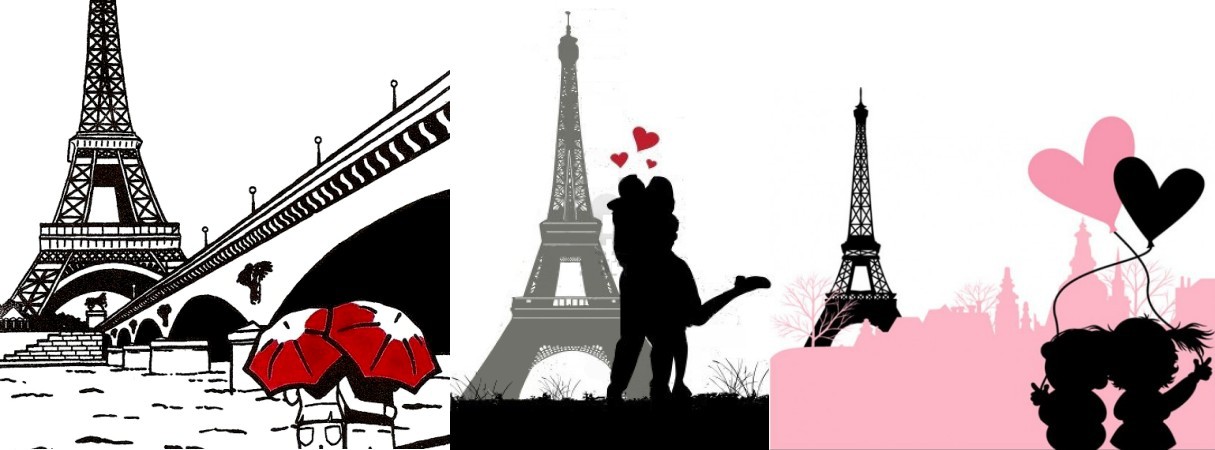
The Eiffel Tower of Paris is quite possibly the most
powerful icon on our planet.
Along with the Statue of Liberty, the Great Pyramids of
Egypt, and the German castle Neuschwanstein, and the Roman
Colosseum, one look at the Eiffel Tower immediately conjures
up images of the place it represents.
Has it occurred to anyone how helpful it
would be to have a powerful iconic image of our own to advertise
Houston world-wide?
|
Rick Archer's Note:
I find it interesting that Mr. Baldwin's article above
concluded with a mention of the Eiffel Tower of Paris.
Did you know the Eiffel Tower has something in common with
the Astrodome? In 1909, they almost tore the structure
down. Yes, indeed, like our own Astrodome, the Eiffel
Tower was no stranger to controversy.
THE
EIFFEL TOWER CONTROVERSY
Most of the people
of Paris opposed the construction of
Eiffel Tower. The
citizens thought it
was nothing
but the wastage of money.
The citizens of Paris
were shocked when they saw
Gustav Eiffel along
with his workers start constructing the tower.
The thing that shocked them was the
hideous design which he
imposed upon their city.
Mais
oui, très répugnant!!
In dispute,
many reputed personalities from
various
fields like composers, artists, writers and
leaders of cultural heritage went to the
minister of Paris to
complain the tower was
a
monstrosity, a waste of
public money and useless.
There was great fear as well.
The residents who were
living at the Champ de Mars thought that the
monster made up of metal
would surely fall,
destroy their homes and
crush them in the process.
The issue became more drastic when a nervous
citizen filed a suit against the Paris City to
restrict the construction work of tower. The
construction process came to halt.
Now Gustav Eiffel was
forced to provide assurance to the residents
about the tower. He
promised he bore all
responsibility for accidents that might occur
because of this tower.
The scientific community was convinced Eiffel
didn't know what he was doing.
One professor of
mathematics at a Paris
university
wrote that if the height of tower increased to
748 feet, the tower would definitely fall
(the Tower is 986 feet high).
Sight lines were being ruined.
Residents
living along with the tower
complained the
tower would disrupt the natural
beauty of the city.
There were great fears about lightning.
At that time, people
had no idea about thunderstorms and
lightning.
Would the Tower be struck by lightning and cause
a great fire with sparks flying everywhere?
Some worried that
electrical currents from
lightning
would be transmitted through
the metal structure deep into the ground and
kill the fish in the nearby
Seine River.
Most of the people
who love nature were against the construction of
this tower too. What a
shame that a lovely park full of trees had to be
destroyed to make room for this eyesore.
(source)
|
The
Eiffel Tower was named after engineer Gustave
Eiffel. It was his company that designed and built the tower.
Erected as the entrance arch to the 1889 World's
Fair, it was heavily criticized by some of France's
leading artists and intellectuals.
Nobel prize
winning author Emile Zola pronounced it the "Tower of
Babel" and considered it dishonorable to the spirit
of Paris.
Author Guy de
Maupassant had a famous insult. He hated the Tower so much that he paradoxically
chose to eat lunch there every day. Why?
Being on
top of the tower was the only place in Paris where
he didn’t have to see the damn thing rising into the sky.
Even after it
was built, the Eiffel Tower controversies continued.
Everyone continued to complain about it.
Believe it or not, the Eiffel Tower was very nearly torn
down.
Although it
seems impossible to imagine Paris without the Eiffel
Tower, the
Tower was scheduled for demolition in 1909.
The only thing that saved the Eiffel Tower from
being heaved onto a massive scrap pile was the
realization of its potential importance in a
burgeoning new form of communication: transatlantic
radio communications.
Although the height of
the tower was a factor in much of its early
criticism, ironically it was the height of the tower that ultimately
saved it.
Today all that
controversy is laughable. Over time, the
Eiffel Tower has become one of the most recognizable
structures in the world. The Eiffel Tower is
now the dominant
global icon of both Paris and France as well.
No picture of Paris is complete without it.
The Eiffel Tower received
its 250 millionth visitor in 2010. According to
Wikipedia, the Eiffel Tower is the most-visited
paid
monument in the world. In addition to millions of
people who simply walk over to take a look,
seven million people ascended
it in 2011.
Out of
curiosity, do you still want to tear down the
Astrodome?
|
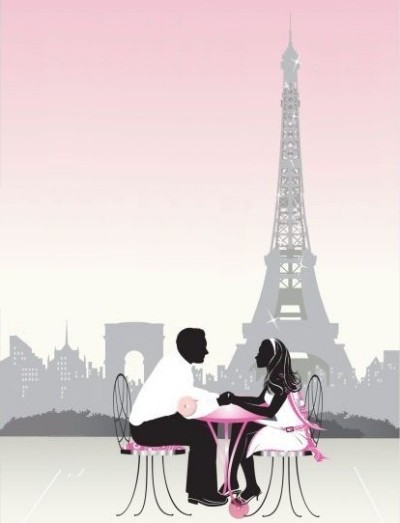 |
|
"Compared to other
cities, Houston is
pretty ugly."
|
Rick Archer's Note: Several years ago I ran
across a story in the San Francisco Chronicle that made my
blood boil.
The story was written by a smug San Francisco sports writer
to explain why San Francisco was chosen as the USA finalist for
the London 2012 Olympic bid over Houston even though Houston
had a far stronger bid at the time.
Let me share some choice quotes from the article:
Compared to other cities, Houston is pretty ugly. -- San Francisco
Chronicle, 2002
|
Perhaps Houston was so desperate to put itself on the global
events map that it chose to overlook the boring flat-terrain
flood basin where it is located. -- San Francisco
Chronicle, 2002
|
So it's rather amusing that second-tier towns like Houston
continue to huff and puff when they get left at the
threshold when competing against the San Franciscos of the
world... or for that matter, the likes of London and Paris
and New York.
-- San Francisco Chronicle, 2002
|
For all those civic wannabes in Houston who like to think
their city's stock is now on par with the likes of New York
and San Francisco, it helps to remember the small things. The 110-degrees-in-the-shade concept is a sure brochure
bouncer.
Oil refineries may be a great boost to the
local economy, but smoke and haze and skylines full of
petrochemical plants don't exactly send Europeans racing to
their travel agents.
The good people of Houston will accept this over time, just
like all the other cities have when they try to pass
themselves off as the equal of San Francisco or Paris.
--
San Francisco Chronicle, 2002
|
I
could share some more quotes, but I think I have made my
point. Incidentally, if you would like to read the
article in its entirety, be my guest:
Hey
Houston... Better luck next time!
On the other hand, maybe it's time we all took a good look in the
mirror. When it comes to natural beauty, Houston has
little. Our city could be a forest, but it is a
concrete nightmare instead. When it comes to a choice between billboards
or thick groves of trees lining our freeways, we all know who wins that
battle. When it comes to surefire tourist attractions
on par with Las Vegas as a magnet to bring people to our
city, not much comes to mind.
|
|
|
San Antonio, the Tourism Leader
of Texas
|
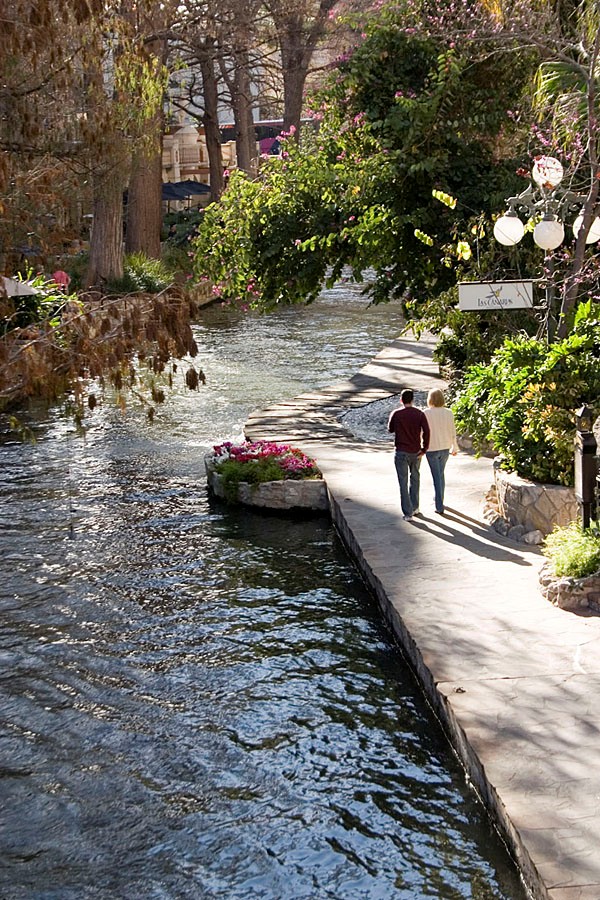 |
Currently, San Antonio has the strongest tourist
industry in Texas.
Tourism brings huge dollars to the city.
According to Wikipedia,
over twenty million tourists visit the city and its attractions every
year. This is primarily due to the Alamo and the Riverwalk as well as SeaWorld
and Fiesta Texas.
As one might guess,
these tourists contribute substantially to the city's economy.
The Henry Gonzalez Convention Center alone hosts more than 300
events each year with over 750,000 convention delegates from around
the world.
And why do so many
people want to come to San Antonio for these events? Because
the Riverwalk gives them something fun to do in the evening after a
long day of meetings and lectures.
Tourism employs 94,000
citizens and makes an economic impact of over $10.7 billion
(yes, Billion) in the
local economy. This is revealed in the Economic Impact Study conducted
every two years by the San Antonio Tourism Council and Trinity
University.
Tourism brings
in an additional $300 million in
annual revenues to the City of San Antonio and other governmental
entities. This comes from hotel taxes, sales taxes and other revenues
from hospitality agreements and contracts.
Yes, it is
true, by lucky coincidence, the Alamo, our
greatest Texas icon, is conveniently
located right across the street from another state icon, the San Antonio River Walk. Nor do
San Antonio's blessings end there... the Alamodome
and huge convention centers are all within easy walking
distance.
However, does
that mean we must cry in our beer? We have NRG Stadium right next door to the Astrodome.
If we put a rain forest and a river walk in the
Astrodome, then maybe we could attract more events to
NRG Stadium.
For that
matter, a renewed Astrodome could fuel economic
development in the area. Economic
development would surely follow the moment the tourists
start to show up. One can
imagine structures such as hotels being built
nearby.
Tourism
is a valuable commodity for any city. If we do the
Astrodome project the right way,
then it could become a tourist magnet just like the San Antonio
Riverwalk.
But
first we need the attraction.
|
|
| |
The Lament
of Houston: We Want More Tourists!!!
|
Rick Archer's Note: This article appeared in
the
Houston Chronicle recently. I thought this
article would help illustrate my points
about the dire straits of Houston's current tourism industry
and explain the economic benefit of creating a major tourist
attraction.
Houston Tourist Board Pushes
Harder
Latest Push includes major
marketing to Mexico visitors
(Houston
Chronicle story)
By
Erin
Mulvaney
and L.M. Sixel
April 28, 2015
Boasting the
state's largest airport system and a thriving business
community, Houston has long been known as a hub for
business travelers. But when it comes to drawing
tourists, the city can't compete with places like
Chicago, New York or even San Antonio.
Now,
local tourism officials hope a spike in their
promotional budget and the opening of several new
international flights in and out of town will convince
leisure travelers that Houston is a place to visit in
its own right.
They are set to
unveil what they call the city's "boldest bid ever" to
increase the number of annual visitors by 35 percent
over the next three years.
The project being
announced Wednesday is the first major initiative since
the Greater Houston Convention and Visitors Bureau
Houston was folded into Houston First Corp. last summer
in an effort to eliminate overlapping functions and more
efficiently attract conventions and tourists.
Adding resources
from the better-funded Houston First increased the
budget to promote Houston to $8.8 million, from $5.1
million.
The plan includes
the first major marketing push in Mexico, with
television and newspaper ads as well as promotional
trips for travel agents.
The city
already attracts 1 million Mexican tourists annually,
and new international flights could increase that number
further.
Local
boosters also want to tap the millions of potential
visitors from elsewhere in Texas and nearby Louisiana.
The quasi-public
Houston First owns the Hilton Americas-Houston hotel and
manages several city-owned properties, including the
George R. Brown Convention Center, Miller Outdoor
Theatre, Wortham Center and Jones Hall for the
Performing Arts. Revenue from those projects is helping
to pay for the broader promotional efforts.
Houston
First hopes to boost the number of visitors to 20
million by 2018, up from 14.8 million people last year,
and add 20,000 new hospitality jobs while increasing
local and state tax revenues.
Stephanie Haynes,
president of Hotel & Lodging Association of Greater
Houston, said corporate and convention visitors keep
hotels full during the week, but hoteliers want to
increase weekend and holiday traffic.
"I think Houston has
had some issues with defining the role of tourism
and understanding its impact in the city," Haynes
said. Houston First, she added, "is trying to shift
the image of the city as truly being something that
is not just a convention and corporate destination,
but somewhere you can bring your family or where you
want to visit."
Haynes added that
Houston's lack of an iconic image "has been a
major challenge
for us."
"Houston is almost
a hidden gem when you realize all the things there are
to do in the city," she said. "We are trying to get the
word out and create a plan."
Past efforts to
attract tourists have included advertising campaigns
such as "Houston's Hot" and "Houston: Expect the
Unexpected" and promotions with celebrity Houston
natives like Jim Parsons, Lyle Lovett and ZZ Top.
The newest effort
from the expanded visitor bureau also has focused on
attracting more conventions to Houston which could, in
turn, boost tourism as convention-goers linger a few
extra days. Boosters say Houston also benefits from
hosting big upcoming events like the Super Bowl and the
NCAA Final Four.
Already, most of
the visitors to Houston are classified as leisure
travelers.
Of the
14.8 million who came to Houston last year, about
9 million were leisure travelers while the others came
on business. The majority of visitors come from inside
Texas, including Dallas/Forth Worth, Austin and San
Antonio.
By
comparison, Chicago gets 42 million visitors annually,
New York City 54 million and
San Antonio
attracts 31 million.
Jorge Franz,
senior vice president of tourism for Houston First, said
that even though Houston doesn't have the Magnificent
Mile, it has the Galleria - already a huge draw for
Mexican tourists. Instead of the San Antonio River Walk
or SeaWorld, it does have the Kemah Boardwalk and the
Museum of Natural History.
The city is also
seen as a natural draw for visitors from Louisiana,
especially New Orleans, Lafayette and Baton Rouge, Franz
said.
The airport system
puts Houston in position to draw more leisure travel,
Janice Langlinais, spokeswoman with the Texas Travel
Industry Association. In 2013, she said, visitors spent
$11.2 billion in Houston and $13.6 billion throughout
the metro area. During that time, Austin had $5.4
billion in visitor spending and Dallas $10.5 billion.
Langlinais, a
Louisiana native, also called the city a "hidden gem."
She remembers coming to the city from her hometown as a
child because of the AstroWorld theme park, now long
gone.
One of the goals Houston First noted in its announcement
was a "renewed effort to draw a major new attraction or
identifiable icon to the area."
(Rick Archer's Note: curiously, no mention was made of
the Astrodome)
"Houston is one of
those places people come in and out of. It's good they
are looking to increase their image," she said. "Houston
can show there are interesting things to stay for."
People come from
all over the world to Houston, through the Port of
Houston for cruises, through its large airport system
for connecting flights or for business trips and
conventions, said Michelle Weller, a Houston travel
agent with Travel Leaders. She said people might tack on
a few days in Houston and realize there are a lot of
sights to see and places to visit.
But it's not
necessarily the type of place, like Orlando's
Disneyland, that her clients clamor to visit.
Weller agreed that a defining or iconic venue would help
make Houston a more attractive destination.
"They don't see it
because we are spread out," she said. "Maybe if they
just promoted everything we have a bit more."
In the last two
years, the airport has welcomed several airlines from
Mexico as well as Turkey, China, South Korea, Japan and
Sweden. The latest announcement was an Air New Zealand
flight to Auckland.
Southwest Airlines
will add several new flights to Latin America once it
completes its five-gate international terminal at Hobby
Airport in October. Spirit Airlines is bringing new
Mexico and South American flights to Bush
Intercontinental next month.
Airline analysts
and city leaders tout the new connections, saying they
will increase Houston's visibility as an international
city. About half of those who board flights in Houston
begin here. A large portion of traffic through Bush
Intercontinental and Hobby are connecting flights.
"It's very
opportune to start an ad campaign in Mexico, where they
already get traffic," said Pete Garcia, an aviation
consultant and executive director of The Woodlands-Gulf
Coast branch of the U.S. Mexican Chamber of Commerce.
"Houston does need to promote themselves to stimulate
the market."
Franz will present
a study by Partner International, commissioned by
Houston First, to the Hotel and Lodging Association on
Thursday.
Comparing Houston
to San Antonio, New Orleans, Los Angeles, Chicago,
Atlanta and Philadelphia, it found the total number of
visitors is low, transportation and signage are issues,
and the hospitality industry is not fully engaged in
leisure promotion.
"It's really a
perception thing," said Jason Draper, assistant
professor with the University of Houston's Hilton
College of Hotel and Restaurant Management, citing the
city's arts and entertainment, sports and restaurants.
"Once you come,
you see how much Houston has to offer."
|
BOTTOM LINE: SAN ANTONIO 30 MILLION
TOURISTS PER YEAR, HOUSTON 15 MILLION
TOURIST PER YEAR. |
Rick Archer's Note:
I found the reactions of Chronicle readers to be particularly interesting.
LETTERS
TO THE EDITOR
01. Tom:
All of the above comments are valid and, in
addition, I'd like to use the example of the
future botanical garden's location, near I-610 ,
outside the loop, close to Hobby Airport as a
prime example of how
Houston continues to fail in its awareness and
direction in becoming a true city in the total
sense of the word , in other words, create an
environment worthy of visiting.
The powers that be either don't get it or
think that it doesn't matter that the venues of
interest, in Houston,
are so isolated from one another as to cause a
disconnect psychologically with local residents
and prevents anyone who wants to find Houston as
an interesting place to visit to not find it
worthy of visiting. Houston has a total lack of
infrastructural consistency, density, and
proximity from one point of interest to another
period.
Houston needs pedestrian oriented areas that
can be accessed in a safe, tension free and
convenient way to create that synergy that gives
life to a city.
But that's just part of the issue. The other
factor is that because of the amount of street
people hanging around the majority of venues in
downtown , midtown and the medical center, this
environment is continuously in a street people
mode of existence and, coupled with the homeless
shelters, halfway houses and food pantries,
attracts that demographic that makes a large
part of the population of Houston stay away
leaving whatever few tourists we have feel
isolated in a hostile environment.
Houston is not a
great place to visit in my opinion.
(RA Note: I agree Houston could use a
nice place to walk, but I would like to
point out that the sidewalks here in the
Heights are virtually empty come summertime.
However, a walk inside the Astrodome
sounds wonderful.)
|
02. Sarah:
[The people quoted in the article are]
are delusional if they think it's just a
"perception" issue for tourists. Houston's
attractions are spread out too far and wide and
lack real mass transit options for those who
wish not to rent a car.
As most residents here
believe, Houston is a great city to live in
because it lacks zoning and creates all kinds of
opportunities for residential and commercial
growth.
But the downside is that
because there are several prevailing interests,
zones for leisure and tourism growth will never
be organized well enough to attract the kind of
capital it would take to make Houston's image
compete with cities who are historically and
culturally more iconic than Houston which didn't
really take off until after 1950.
|
03. Roadchick:
[Referring to the article...]
Good luck with that. I've been around long
enough to remember the spectacular failures of
"Houston's Hot," which actually tried to use our
humid weather as a selling point, and "Expect
the Unexpected," which I believe was former
Houston first lady Elyse Lanier's idea.
It's asking way too much
of a visitor to rent a car and navigate a very
large city with a confusing road system and
terrible traffic, where most of the attractions
aren't even in Houston proper. If we had
committed to decent regional transportation 30
years ago, this city would be a lot more
tourist-friendly.
(RA Note: The point of an Astrodome
complex is that everything becomes within
walking distance just like in San Antonio.)
|
04. Amukhi:
I always struggle when asked "What's there to
see in Houston?"
(RA Note: Amen to that.)
|
05. Andrew (replying to
Amukhi):
How about the Museum of Fine Arts? Wortham
Theater Center, Alley Theatre. Museum of Fine
Arts. The Menil Collection. Minute Maid Park.
Memorial Park. The Orange Show. The Beer Can
House. The Galleria. Johnson Space Center/NASA.
(RA Note: Here is my take. The
Johnson Space Center is a nice place to
visit, but with Houston's role in the Space
Program mysteriously diminished, this is not
much of a draw at the moment. Wortham
Theater, Alley Theater, museums, all good,
but not major iconic attractions outside the
city.
Memorial Park? I love it, but most
towns have parks of their own. Why
drive to Houston?
The only one I agree with is Minute Maid
Park...
CUERO, TEXAS
How about a weekend in Houston?
Let's say someone lives in
Cuero, Texas, halfway between San Antonio
and Houston. We are talking about a
Mom and a Dad and two kids. They are
looking for something interesting to do on a
weekend. As it stands, right now San
Antonio gets their business. Sea
World. Fiesta Texas. Whatever.
However, what if someone could park their
car at the Astrodome Complex, hop a fast
train to Minute Maid Park and see the
baseball game?
Then after the ballgame, they could take
that train back to their Astrodome hotel,
freshen up, then take a monorail from their
hotel over to the
Astrodome for dinner. After dinner,
how about a walk along the water or a boat
ride in the canal
with the kids? Or maybe Dad could take
the kids and climb the Astrodome mountain
while Mom enjoys the music at the Astrodome
Magic Fountain beside the Lagoon.
Then the family could spend the night and
perhaps even visit
the Astrodome again in the morning before
the two hour drive back to Cuero.
LAKE CHARLES,
LOUISIANA
Now how about Lake Charles near the
Louisiana border? A young man wants to
impress his girlfriend. Local gambling isn't
going to cut it. Not exactly
"romantic".
What if there was a
nightly
show in the Astrodome? This
young man and his girlfriend could drive
into Houston, have dinner, take a long walk
through the rain forest complete with
margaritas, take a look at the mountain and
the waterfall, see the Magic Fountain, enjoy
a boat ride, then stay and watch the show.
Cirque du Soleil-style acrobatics, a live
band to follow, dancing, a big public party.
This sounds like serious FUN!!
Take the monorail back to the hotel and head
back home the next day with a big smile on
their faces.
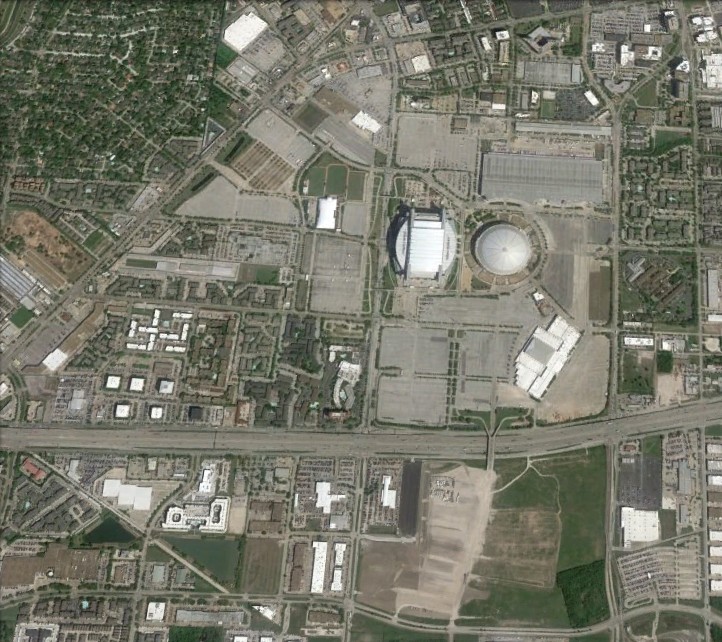 |
While I am at, I
can't imagine why the major
proponents of demolishing the Astrodome
would object to
attracting tourists to the Astrodome
complex.
If anything, I would
imagine the Houston Texans and the
Houston Rodeo would stand to gain from a
tourist attraction on the magnitude of
something like an Astrodome River Walk.
Come see the Rodeo, stay for the
Astrodome!
An aerial view of
the NRG complex shows a vast amount of
unused space just begging for economic
expansion.
Has anyone ever
considered that all that room could be
used for new convention centers, new
hotels, and even a "Mall"??
Both entities say
they crave more parking. I confess
this argument leaves me baffled.
I have a simple
reply: "Parking Garage".
What about the
tailgating experience?
People have the
ability to adapt. Design each level
in a parking garage to have areas
reserved for tailgate groups.
A
roof will reduce the temperature, fans
will do the rest, rain won't be a factor
and the music will be just as loud.
|
|
06. Frank (replying to
Andrew above):
Really, JSC, baseball, museums, etc, those are
Houston's big tourist selling points?
You can do every one of
those things in most other U.S. cities.
In fact, there are way
better tourist locations in the U.S. than Houston.
I mean, if you really want theater, you go to New
York. Baseball you can find in any
major city USA. Heck, NASA is even better
in Florida plus they have beaches and great
amusement parks. I don't think the Astros and
Texans are a big enough draw. I think Dallas or
San Antonio are better Texas tourist spots.
Houston needs something
better.
(RA Note: Amen to that. Houston
clearly needs something better.)
|
07. Nick:
A lot of people that come into Houston
and stay downtown end up with
a bad image of the city because it's
nearly impossible to get around without a car.
So they're stuck Downtown where there's
been very little to see.
Forget Kemah and the Astrodome, that's just
more sprawl. Keep committing to putting more
interesting things Downtown and Houston will
surely become an interesting tourist attraction.
It's a shame that the Southeast Texas
Historical Museum or whatever isn't being built
after all...
(RA Note: And what exactly did Nick
have in mind to put downtown? I say
connect Downtown and the Astrodome complex
together by rail and have the best of both worlds.)
|
08. Doris:
need a themepark
(RA Note: I admire Doris. She has
the ability to say in three words what takes
me a book to write.)
|
09. Marsha:
Instead of focusing on words, promotion and
image, how about creating some actual places
that are worth visiting?
It wouldn't be a bad idea to make the city
pleasant to look at while we're at it. As long
as we're beholden to business (resulting in our
blight of billboards), allow things to be
constantly torn up due to lack of planning (with
resulting streets, ramps and overpasses that
look bizarre and/or hideous), and suffer the
effects of lack of zoning (which has its charms,
but more so its dysfunctions), we aren't going
to win any beauty pageants.
As a visiting friend put it: "Houston has a
tremendous amount of visual clutter."
(RA Note: Tell it like it is, Marsha!
I agree...
"How
about creating some actual places that are
worth visiting")
|
10. Ralph:
We need an iconic image to enhance tourism?
Why not the historic Astrodome, the city's most
recognizable structure?
(RA Note: Amen, Ralph)
|
11. Frank (replying to
Ralph):
I guess you didn't get the memo, the Astrodome
is closed.
(RA Note: Thanks, Frank, we
appreciate the sarcasm.)
|
12. Matthew:
If some kind of train connected the airports to
downtown and other tourists destinations, then
more people might come into downtown Houston.
(Yes!!)
Imagine if you could fly
into Hobby, then jump on a train to Galveston. Then
visit the JSC on the way back, then on to
the museum district and then downtown for a
night
baseball game. Big day!
Chicago and New York have
a train to get around. San Antonio doesn't have
a system, but it seems most people either are
going downtown to the Alamo/Riverwalk or Sea World/Fiesta
Texas.
Houston actually has a lot
to offer visitors, but it's just hard to get
around, especially with every highway seemingly
under construction.
(RA Note: Amen, Matthew. Rapid mass
transit is an important feature of every
major city in the world. When I was in
Paris, I took a train to Versailles ten
miles outside Paris, rode the train back to
the Eiffel Tower and then walked through
scenic Paris back to my hotel.)
|
13. Frank (replying to
Matthew):
Ugh, tired of seeing baseball as a selling
point. Frankly there is really nothing worth
visiting in Houston.
Dallas and San Antonio are
much better tourist destinations. Galveston can
also stand on its own. I'd rather spend some time
and money in Galveston than in Houston.
(RA Note: I agree. When my
relatives come to visit, I agonize over what
to take them to see here in Houston.)
|
14. Matthew (replying to
Frank):
You would be surprised how much baseball brings
visitors to cities. Several major league teams
now organize and sell vacation packages for fans
to go to away games. The ones I have seen
usually go to more typical vacation spots though
(west coast, New England, Florida).
Tourism is fickle business because it is
completely based on people's opinions. For
instance, baseball to me is a selling point.
I've planned trips to a couple of cities solely
based on wanting to see a baseball game in their
stadium, then I did other stuff while I was
there. People who like to ski go to Denver and
Salt Lake City. People who like history might go
to Washington D.C. People who like theater and
shows might go to New York or Las Vegas. Not all
of those appeal to everybody.
If Houston wanted to stake a claim to one big
tourist attraction, it could be wildlife
viewing. Houston's position along the upper
Texas coast actually makes it one of the most
popular spots in the country, and the world for
that matter, for viewing birds/wildlife. So much
so, that a National Recreation Area has been
proposed to encircle Galveston Bay to help
promote outdoor recreation in the Houston area.
There are also already 6 federally managed
National Wildlife Refuges within an hour's drive
of downtown Houston. The proposed recreation
area would include most of those among other
parks and be managed and promoted by the
National Park System. This doesn't necessarily
promote Houston specifically, but the area as a
whole (all who would have to drive through or
fly to Houston).
Promoting nature in a city
built on oil might help change the public's
perception of it and bring more tourists in.
(RA Note: In my opinion, baseball,
wildlife, the museum district, Johnson Space
Center and the Beer Can House can all
contribute to varying degrees. But
anyone who thinks these venues have major
iconic value across the world, much less
here in Texas, are just plain delusional.
These locations will not draw people from
outlying areas to our city.
As one cynical relative said to me, the only
good
reason to come to Houston is to make money
or get cured of cancer. Gee, now let's
send that tourist slogan over to the Tourism
Board.
What Houston needs to do is restore our iconic image.
We need to remind the world
that the Houston Astrodome, the Eighth
Wonder of the World, is Back in Business.)
|
|
What
Are We So Afraid Of?
|
Rick Archer's Note:
By coincidence, as I write
this article, Judge Emmett appeared on last night's news
announcing his trip to Germany to see Tropical Island.
Am I the only
one who thinks Judge Emmett acts like he is treading
through a mine field??
For example, when
telling about his upcoming trip to
Germany, he pointed out that "no
tax dollars are being used to fund this fact-finding trip."
He added, "It's important to note that we have no
intention of turning the Astrodome into a tropical island
resort!"
Judge Emmett
seems like a man who is used to looking over his
shoulder.
If I didn't know any better, Judge Emmett has probably heard
the story of Bugsy Siegel.
Bugsy Siegel is the man widely credited with the vision to
make Las Vegas what it is today.
Las Vegas was a two-bit town that no one cared about until
they began building Hoover Dam back in the Thirties.
This project was a gamble to help America out of the Great
Depression. Suddenly 25,000 men flocked to Hoover Dam
looking for jobs. Very few of these men brought their
families along, so a shanty town called Boulder City
was hastily erected nearby. This was good
enough as a place to sleep at night, but soon enough
these countless men wanted something to do with
their free time.
This influx of
men had created an instant
market for large scale entertainment. Las Vegas was
located twenty miles away. This was the place where
the first casinos were built. Showgirls, booze,
prostitution and gambling were thrown into the mix as a way
to entertain the male construction workers. Las Vegas
quickly earned its reputation as a pretty wild town.
|
 |
There was a lot of speculation what would happen to Las
Vegas when the dam was finally completed. Would
everyone go home and let Las Vegas turn into a ghost town?
It sure seemed a waste to let all that investment go down
the drain when the party was over.
Bugsy Siegel was the man who believed Vegas
could be even bigger than it was now. He knew a lot of
high rollers who would love to have a Gambling Mecca strictly for
big shots. With the infrastructure already in place,
Siegel pushed his vision. He persuaded influential
mobsters to put up a lot of money to build the Flamingo, the
first modern Vegas casino.
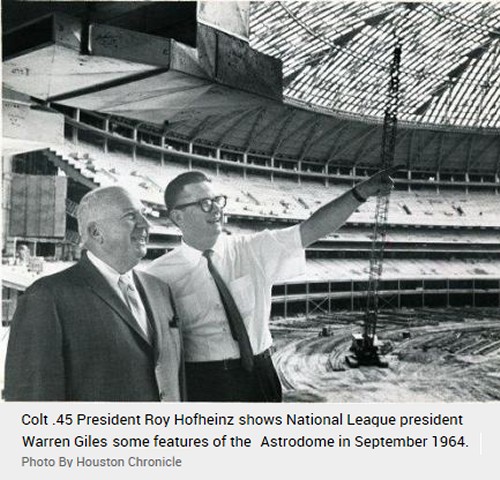 |
Unfortunately
the Flamingo opened before it was ready. The
air conditioning didn't work! The Flamingo got
off to a bad start and lost "a lot of money".
There was also a rumor Siegel's girlfriend had taken
off for Switzerland with "a lot of money". The
betrayal wasn't confirmed, but the rumor weighed
heavily on the minds of the investors. Tired
of the losses and the excuses, the mob bosses lost
their patience and ordered Siegel assassinated.
Oddly enough,
about the same time as Siegel was shot, the Flamingo
had just turned a $250,000 profit in the past two
months... "a lot of money" back in those days.
It was no fluke either. Within a year, the
Flamingo had turned a $4 million dollar profit.
We all know the rest of the story.
As for Judge
Emmett, considering he lost one bond election in
2013 and has some of the most powerful men in
Houston clamoring to tear down the Astrodome, one
can understand why he is forced to tread so
carefully.
"No
tax dollars are being used to fund this fact-finding
trip."
As we have seen with Bugsy Siegel, life isn't always
easy for visionaries. One more misstep could be the
end for Judge Emmett and the Astrodome as well.
In my opinion,
the Astrodome Project should not have to be
completely on the shoulders of Judge Emmett.
Judge Roy Hofheinz was the man with the first
vision. He was the one who talked the people
of Houston into building the Astrodome in the first
place.
All Judge Emmett is trying to do is
find a way to use an existing asset for the public
good. I applaud him for his efforts. It
can't be easy.
|
One of the things that I find fascinating are the
reasons people use to call for the destruction of
the Astrodome.
Did you know there is a plan in
place to spend $66 million just to tear down the
Astrodome (source)?
Why?
Because the Astrodome is in the way of something.
"The
Astrodome impedes circulation flow among two
major axes of Reliant Park".
So you are the
voter. Let's play a game. Do you want to
tear down the Astrodome for $66 million and get
nothing in return but improved walking paths to your
car after the game?
Or do you want
to put a Tropical Island (or something like it)
inside the Astrodome for $111 million? Yes, it
is more money, but if you believed in the vision, would you be
willing to gamble?
To me it makes
far more sense to support the
construction of an iconic
facility that would not only put Houston back on the
worldwide tourist map, but also generate tourist income for the city.
To me, the $217 million bond election
in 2013 was
defeated for a simple reason... building another
convention center didn't make any sense because
Houston had nothing to attract more convention
people in the first place!
But if we had a
heavyweight tourist attraction, then the conventions
might be more inclined to come our way.
|
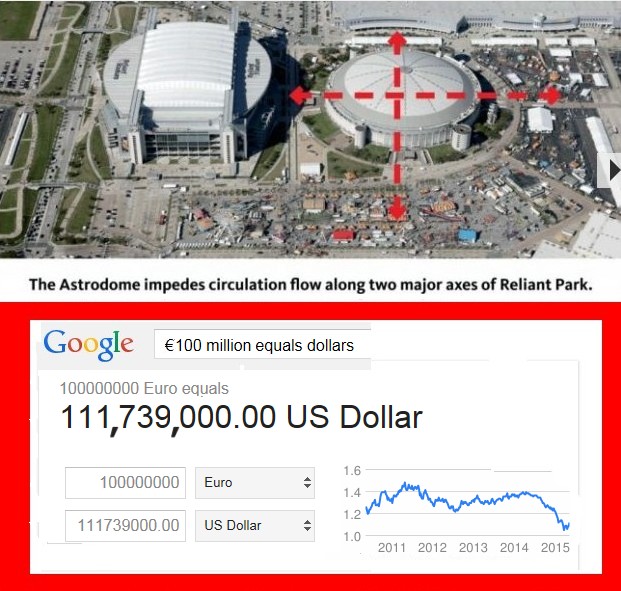 |
 |
|

The San
Antonio Business Model Revisited
|
"If
You Build it, He Will Come..." -- Field of Dreams
|
 |
Rick Archer's
Note:
I have offered two stories from the past where
Gustav Eiffel and Bugsy Siegel had the guts to think big,
were widely criticized, yet ultimately proven
correct.
I would
like to offer
San Antonio's success with the Riverwalk as a third example.
During the 1920s, no
one could have possibly dreamed of the value of saving a curious
bend in the river that passed through the center of town.
Back in those days, the San Antonio River
had more curves than a coral snake or a sidewinder rattlesnake.
Furthermore, the flood
waters caused by those bends in the river were far more
dangerous as any water moccasin.
|
In September 1921, a
disastrous flood along the San Antonio River took fifty lives.
Don't let this happen again! Plans were
quickly developed for flood control of the river.
The
idea was to "straighten out" the river.
This would allow the waters to flow
downstream more rapidly before they could back up in a storm and
create new flooding.
As part of the
Straightening Plan, the engineers wanted to bypass an
unusually prominent curve in the river. Since this headache curve was
in the downtown area, it presented a real threat to property in the
area should another flood occur.
Once the
new straight-line bypass channel was
complete, the water in the wide bend would be drained and replaced by
sewer pipes, then paved over to create new city streets.
Work on the bypass channel began in 1926.
Just like braces and teeth, the San Antonio River
now had a channel that passed straight through downtown.
Sitting next to it was the former bend in the river
that was now ready to be paved over.
However, the second
phase... paving over the no longer useful river bend with a street... did not come to pass.
The San Antonio Conservation Society
successfully protested the paved sewer option. So the water
just sat there in that wide bend for three years while people tried to come up with
ideas what to do with the stagnant water besides raise mosquitoes.
No major plans came into
play until 1929, when San Antonio native and architect Robert Hugman
submitted his plans for what would become the River Walk.
The leadership of former
mayor Jack White was instrumental in passage of a bond issue that
raised funds to empower the 1938 “San Antonio River Beautification
Project”. This began the evolution of the site into the present
2.5-mile-long River Walk.
On a
personal note, I walk the entire route every chance
I get when we visit San Antonio. The Riverwalk is a
special place.
|
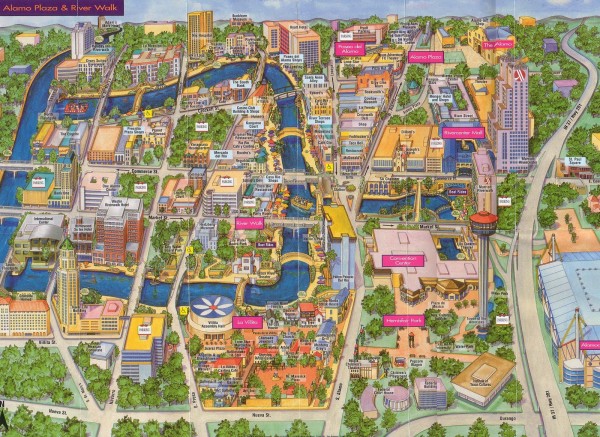
To understand
what the engineers did, they dug a large BYPASS channel on the left that became the
straight part of the river.
The next part of the plan was to
fill the curve with soil and pave it.
Instead, they put dams
between the straight part and the huge curve.
When the river
was slow, fresh water could be allowed into the giant U-Turn. When
flood conditions prevailed, the dams could be lowered to protect the Riverwalk
interior from damage.
Who would have
ever thought that a bend in the river could turn out to be so
valuable?? San Antonio has built an entire industry
around this lucrative area - hotels, restaurants, convention
centers.
The Riverwalk
made San Antonio the envy of all other Texas towns.
|
|
| |
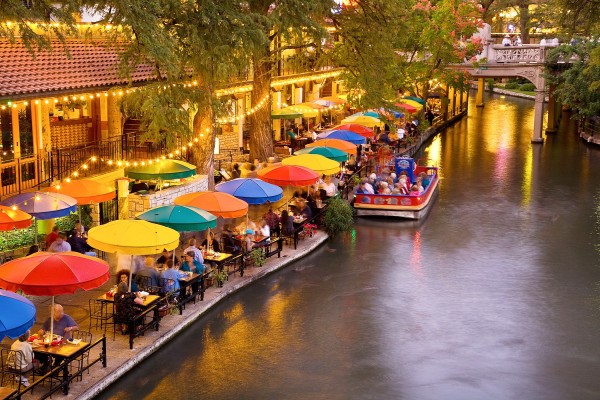
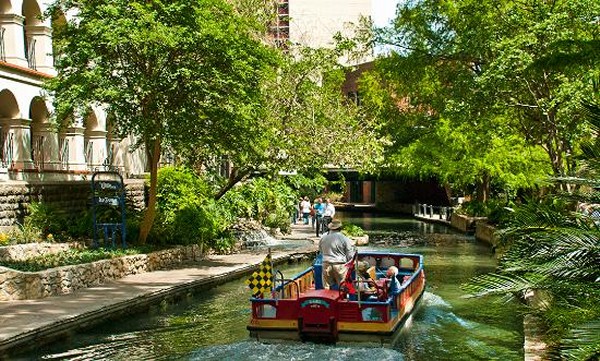 |
Let's
face it: San Antonio got lucky!
Back
then, no one had the slightest idea what would
happen as the result of saving that curious bend in
the river.
But we know now
what the benefits are. These excerpts come from a study done on the economic impact of the
Riverwalk.
Study
Reveals River Walk’s Importance to San Antonio
Economy (source)
Sara Gruber | May 14, 2014
A treasure for locals, businesses and visitors, the
River Walk plays a vital role in the health of San
Antonio’s economy.
To better pinpoint its impact,
the City of San Antonio commissioned a year-long
study to learn more about the number of visitors the
River Walk receives.
The study concluded that 11.5 million people visit
the River Walk annually. Of these, 9.3 million are
from outside Bexar County. These visitors stimulate
an overall economic impact of $3 billion and
directly influence 21,000 San Antonio jobs.
“It is because of significant sites like the River
Walk, that tourism is one of San Antonio’s top five
industries, employing one in eight locals and
contributing $12 billion annually.”
Some 2.2 million River Walk patrons are locals.
Approximately two thirds of local respondents
indicated they visit the River Walk more than twice
a year. This is a key element as the city’s tourism
infrastructure also improves quality of life for
locals and businesses, enhancing the vibrancy of San
Antonio.
“The conservative estimate of a $3.1 billion annual
economic impact of the River Walk...
|
Today San
Antonio stands supreme as the Tourist Mecca of Texas.
Tourism is one of the city's top five industries. One job in
eight depends on tourism. The River Walk alone is
worth $3 billion dollars per year.
While Houston gets 15 million tourists a year, San Antonio
gets 30 million. Don't think for a minute that San
Antonio doesn't know what they have going for them.
They watch their industry carefully. An article in a
recent
San Antonio business journal said the following:
"Several
Texas cities and markets outside the Lone Star State are
throwing huge amounts of money into their tourism
marketing efforts.
“The tipping point was the shear number of dollars our
Texas competitors — Dallas and Houston — have brought to
the table,” Decker said. “Both Dallas and Houston are
going after large segments of the leisure market.”
Those cities are also chasing after a larger share of
the convention business.
So is Austin, which is investing in new hotels and an
expanded convention center.
“There are a lot of reasons for more people to go to
Austin now,” Decker said. “The competition is becoming
so intense. Everybody sees it. Something has to
change. That’s what has driven us to this point
(of investing more money in tourism).”
Please don't misunderstand. I am a huge fan of San
Antonio. I admire what they have done
with their city.
That said,
Houston has every right to compete for some of those tourist
dollars.
So where do we
start?
If I have read
the Houston Chronicle Tourist Board Pushes Harder article correctly, someone's idea of beating San Antonio to
the punch is to spend more money on advertising.
"Adding
resources from the better-funded Houston First increased
the budget to promote Houston to $8.8 million, from $5.1
million."
"Houston is one of
those places people come in and out of.
It's good they
are looking to increase their image," she said. "Houston
can show there are interesting things to stay for."
The
claim is that Houston can show
there are
interesting things to stay for. Like what?
The article didn't mention any places. Why do
you suppose that is?
I have a
question. Does anyone really think spending more money on advertising
is going to help increase tourism here in Houston without something of value to brag about?
The people
quoted in Tourist Board Pushes Harder said it themselves:
One of the goals Houston First noted in its announcement
was a "renewed effort to draw a major new attraction or
identifiable icon to the area."
Ms. Weller said people might
tack on a few days in Houston and realize there are a
lot of sights to see and places to visit.
But Houston is not
necessarily the type of place, like
Orlando's
Disneyland, that her clients clamor to visit.
Ms. Weller agreed that a
defining or iconic venue would help make Houston a
more attractive destination.
|
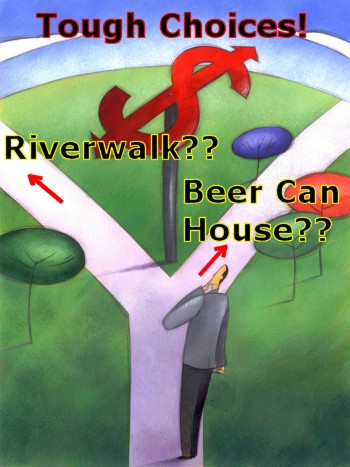 |
One of the goals Houston First noted in its announcement
was a "renewed effort to draw a major new attraction or
identifiable icon to the area."
|
I have
two questions.
Just exactly
what "iconic image" does Houston First expect
to pull out of its hat?
Just exactly
what "major new attraction" does Houston First
have in mind?
Advertising geniuses can talk all they want, but it
seems likely they will just be spinning their wheels
unless we put something on the table to actually
talk about.
I think our
friend Marsha said it the best in her Letter to the Editor:
09. Marsha:
Instead of focusing on words, promotion and
image, how about creating some actual places
that are worth visiting?
|
|
| |
Rick Archer's Note:
I understand
that most Houstonians were not around for the
Astrodome construction back in 1964. It was a very
exciting time to live here in Houston.
However,
due to the passage of 50 years, it is
hard to conceive of the immense civic pride that the people took in
realizing this fantastic dream.
The
Astrodome was the brainchild of Judge Roy Hofheinz,
a colorful and quite charismatic Houston leader.
Back in
the 1950s, Judge Roy Hofheinz became perhaps the
most influential politician in Houston's history.
In a
career that included time as a State Legislator,
County Judge, and Houston Mayor, Roy Hofheinz will
be remembered best for persuading Houston's movers
and shakers as well as Houston's voters to support
his ambitious Astrodomain project.
Keep in
mind the construction of the Astrodome was taken at
considerable risk. Building
the Houston Astrodome was a huge gamble... no one had any
idea if it would work or not.
Adjusting for
inflation, at a cost of $183 million, Houston showed
the world what our city was capable of.
Nor did we stop
there... Judge Roy Hofheinz included the Astroworld in his
original vision.
In its
day, the Astrodome was described as the "Stadium of
the Future" and the "Taj Mahal of Sports".
The
Houston Astrodome literally paved the way to the future.
Astroturf came into being thanks to the Dome.
The concept of skyboxes was originated in the
Astrodome.
Today there are
domed stadiums throughout America. Houston was the leader.
We showed the world it could be done.
It is
important to note that the Astrodome created a
gigantic economic boom for Houston.
According to an article in
The Atlantic, in 1966 the
year after its opening, the Astrodome became America's
third-most-visited man-made tourist attraction.
The
Astrodome ranked only behind Mount Rushmore and the
Golden Gate Bridge as the place to see and visit.
Furthermore, the Astrodome became the anchor for the subsequent
development of south Houston.
"Rollover effect"
is a term for the dollars brought into an area by
economic investment, then re-spent locally.
Economists estimated that when the "rollover effect" was taken into account,
in the Sixties the Houston Astrodome brought
profits to the city in excess of $4 billion. (source)
As for
the Dome and its current state, Dene Hofheinz,
daughter of the Judge, was quoted saying her father
would be disappointed to see the facility in the
state it’s in today.
Ms.
Hofheinz said
her father never envisioned the Dome as a building
to last only a few decades.
The
Astrodome was supposed to be a
Houston landmark that would forever provide
entertainment for families.
“Dad welcomed the problem because he lived to solve
a problem,” she said. “The bigger the problem, the
greater the challenge, the better he felt.”
“He was thinking about Houston and Harris County up
to his last breath.”
|
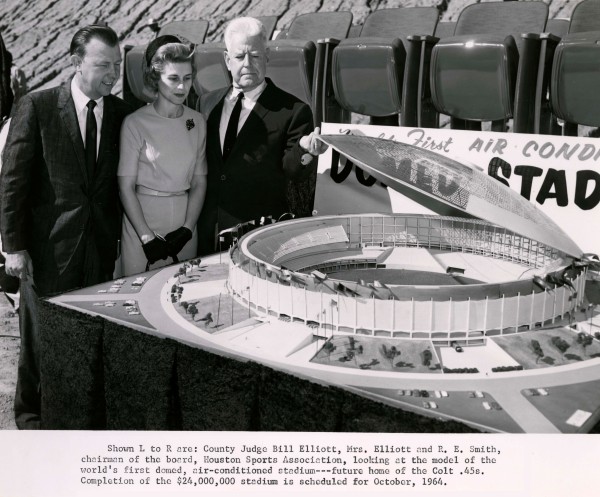
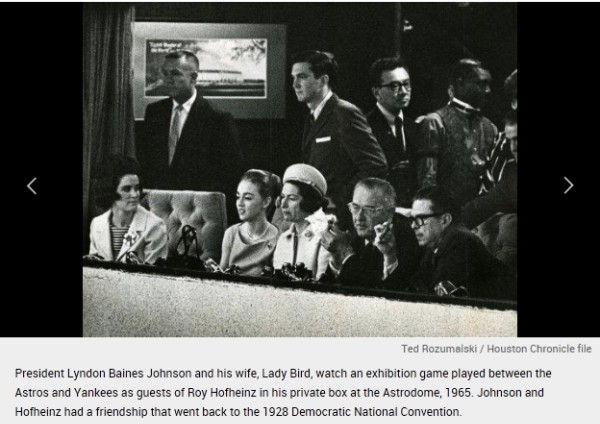
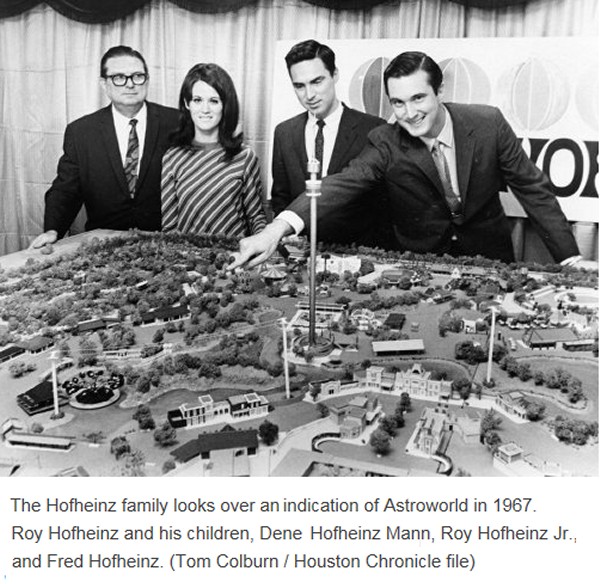
|
Houston, We Have a
Problem
|
Back in Sixties, Houston was a pioneer.
We had the Eighth Wonder
of the World and our Johnson Space Center placed Houston in the center of
the world's eye when America reached the Moon.
Now look at us.
The Space program is dormant, Astroworld is gone, and the
Astrodome is on the brink of destruction.
Where have you
gone, Roy Hofheinz? A city turns its lonely eyes to
you.
There will be
politicians who scream bloody murder over the price tag.
This is as predictable as anything I have said in this
article.
That said,
everyone knows you have to spend money to make money.
We all know that Houston is one of the most prosperous
cities in America. We have the economic muscle to
accomplish whatever we think is important.
However,
Houston's prosperity has recently witnessed a serious storm
cloud. Has anyone noticed that "oil" could be in
trouble?
Why allow our
city to be so dependent on one industry?
The problem with
the Astrodome might actually be a blessing in disguise.
The resurrection of the Astrodome can coincide with a
prudent decision to diversify Houston's economy. It
makes complete sense to add "TOURISM" to our city's
portfolio.
Unfortunately,
until we create something interesting enough to generate
world-wide curiosity, the advertising people will just spin
their wheels.
We have no
choice but to make a sizeable investment. I contend
that the Astrodome is the most practical road to take.
When the dust
clears, even the critics will admit there is only one place in Houston capable of becoming an
iconic image for Houston: The Houston Astrodome.
The Germans have
shown us the way - turn a lemon into lemonade. No
other large-scale project makes a bit of sense.
The story of the
first incarnation of the Astrodome has shown us what can
happen when some real thought is put into the process. Fortunately it
is not too late for a Second Act.
In the process
of restoring the Astrodome to prominence, the entire world
will watch on with fascination. If we do it in style, Houston can regain
its rightful place on the world stage.
Roy
Hofheinz did it once. His Astrodome created a
gigantic economic boom for Houston.
The
Houston Astrodome was once the Eighth Wonder of the World. The
Theme of Act Two becomes obvious. It is high time to
return the Eighth Wonder to renewed glory!
We know how San Antonio makes its money.
If Houston ever intends to compete not just in
Texas, but worldwide, for tourism dollars, it is
high time to take a good look at the Astrodome and
put something in there that will knock everyone's
socks off.
With some imagination and Texas-style
ambition, Houston can
put itself back on the map of Texas for tourist dollars.
It happened once; it can happen again.
|
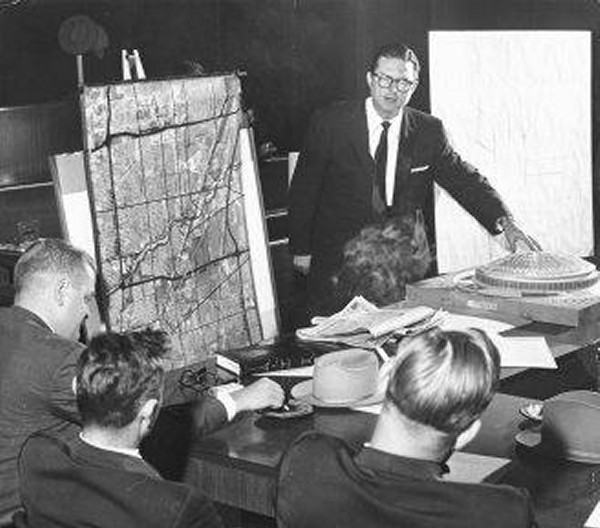
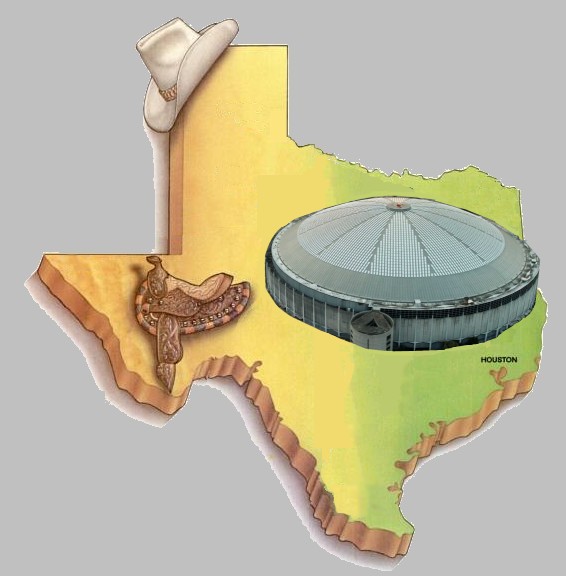 |
|
|
About Rick Archer:
A
graduate of St. John's School here in Houston, I ran
SSQQ Dance Studio here in the Houston area for
thirty-two years.
After
retiring in 2010, I turned my attention to writing
among other things.
It is
important to note that I do not have a horse in this
race. I know absolutely no one connected with
the Astrodome struggle nor do I stand to make any
money one way or the other. Due to the fact
that I have no economic stake in whatever happens, I
have the luxury of saying exactly what I think
should be done.
If you
have enjoyed this article, please note there is an
accompanying page:
Astrodome Project.
In this article, I stated many of the same ideas I
have shared here plus all sorts of fanciful ideas
about what to do with the space inside the Dome.
If you
wish to contact me, I can be reached by email,
rick@ssqq.com
|
|
|
|